Strategic Management Report: Tesco, Unilever, and Bang & Olufsen
VerifiedAdded on 2022/12/23
|9
|991
|50
Report
AI Summary
This report provides a comprehensive analysis of the strategic management practices of Tesco, Unilever, and Bang & Olufsen. It begins with an overview of the strategic solutions implemented by Tesco and Unilever, examining their market segments, portfolio, market position, and competitive landscape. The report delves into the Porter's generic strategies and Ansoff Matrix applied by both companies, highlighting their approaches to cost leadership, differentiation, market penetration, market development, product development, and diversification. Furthermore, the report includes a reflective analysis of Bang & Olufsen's strategies, focusing on its business-level and corporate-level strategies, such as focused differentiation, market penetration, diversification, internationalization, market development, and product development. The analysis is supported by references to relevant academic literature.
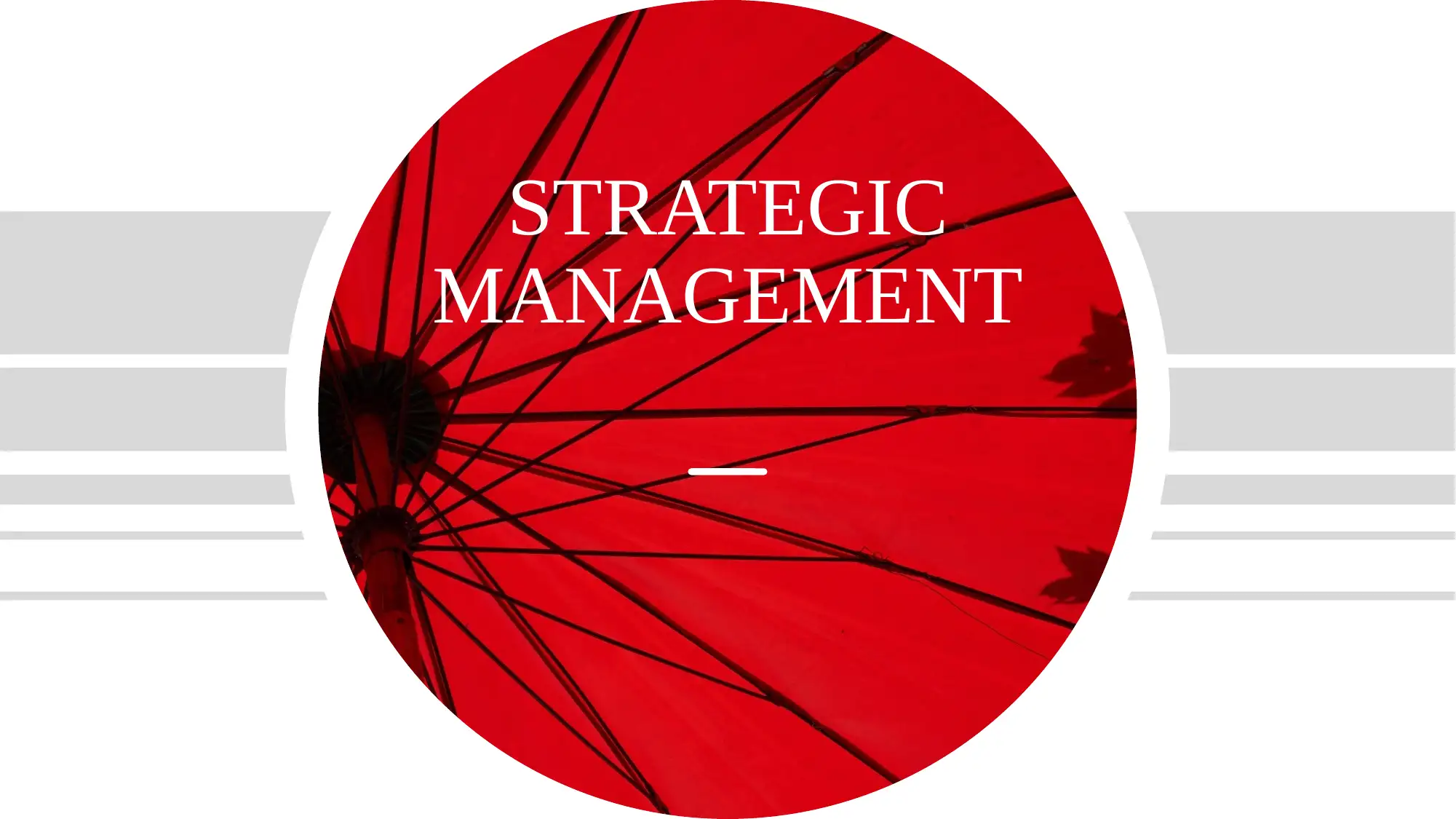
STRATEGIC
MANAGEMENT
MANAGEMENT
Paraphrase This Document
Need a fresh take? Get an instant paraphrase of this document with our AI Paraphraser
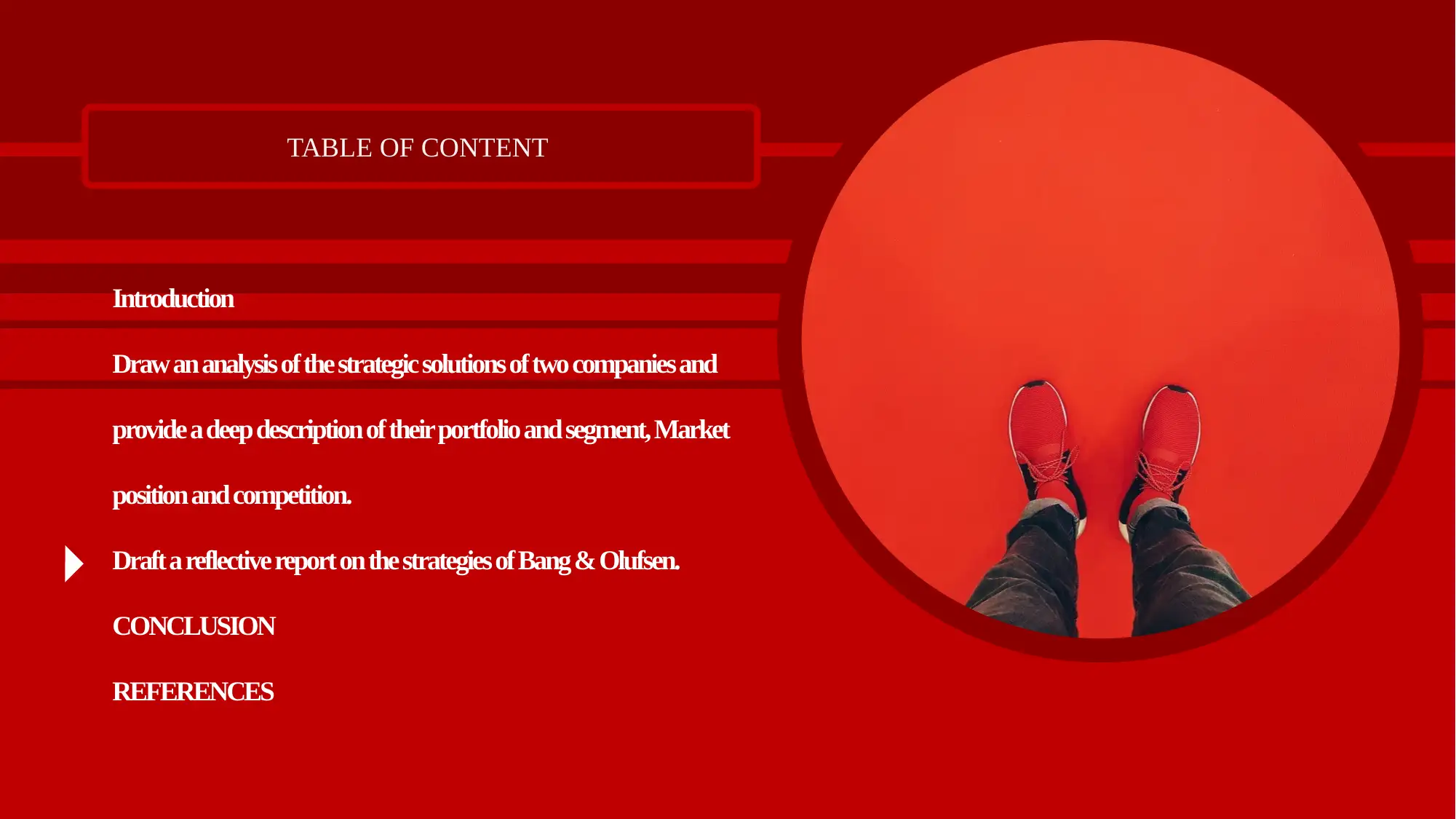
TABLE OF CONTENT
Introduction
Draw an analysis of the strategic solutions of two companies and
provide a deep description of their portfolio and segment, Market
position and competition.
Draft a reflective report on the strategies of Bang & Olufsen.
CONCLUSION
REFERENCES
Introduction
Draw an analysis of the strategic solutions of two companies and
provide a deep description of their portfolio and segment, Market
position and competition.
Draft a reflective report on the strategies of Bang & Olufsen.
CONCLUSION
REFERENCES
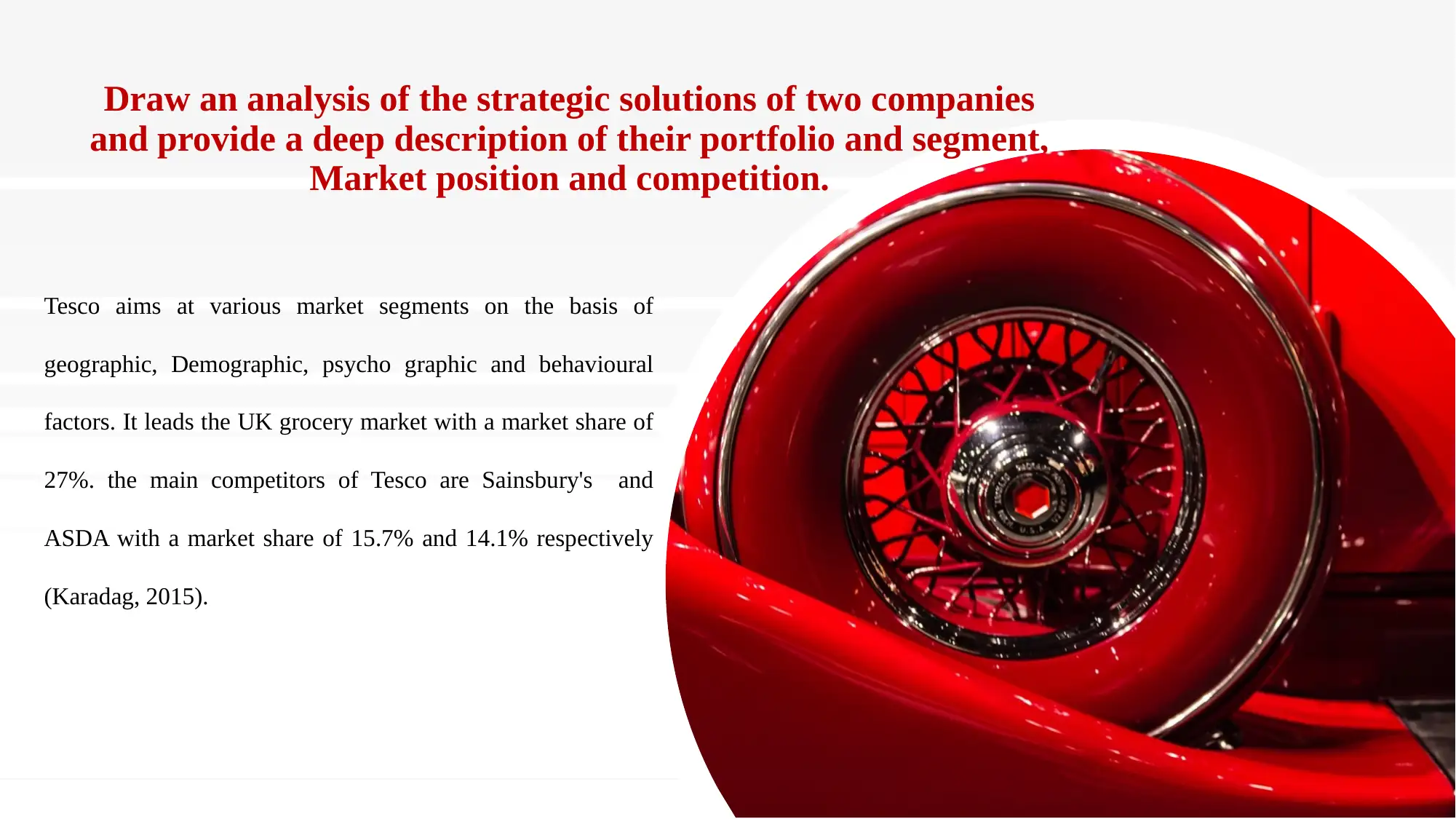
Draw an analysis of the strategic solutions of two companies
and provide a deep description of their portfolio and segment,
Market position and competition.
Tesco aims at various market segments on the basis of
geographic, Demographic, psycho graphic and behavioural
factors. It leads the UK grocery market with a market share of
27%. the main competitors of Tesco are Sainsbury's and
ASDA with a market share of 15.7% and 14.1% respectively
(Karadag, 2015).
and provide a deep description of their portfolio and segment,
Market position and competition.
Tesco aims at various market segments on the basis of
geographic, Demographic, psycho graphic and behavioural
factors. It leads the UK grocery market with a market share of
27%. the main competitors of Tesco are Sainsbury's and
ASDA with a market share of 15.7% and 14.1% respectively
(Karadag, 2015).
⊘ This is a preview!⊘
Do you want full access?
Subscribe today to unlock all pages.

Trusted by 1+ million students worldwide
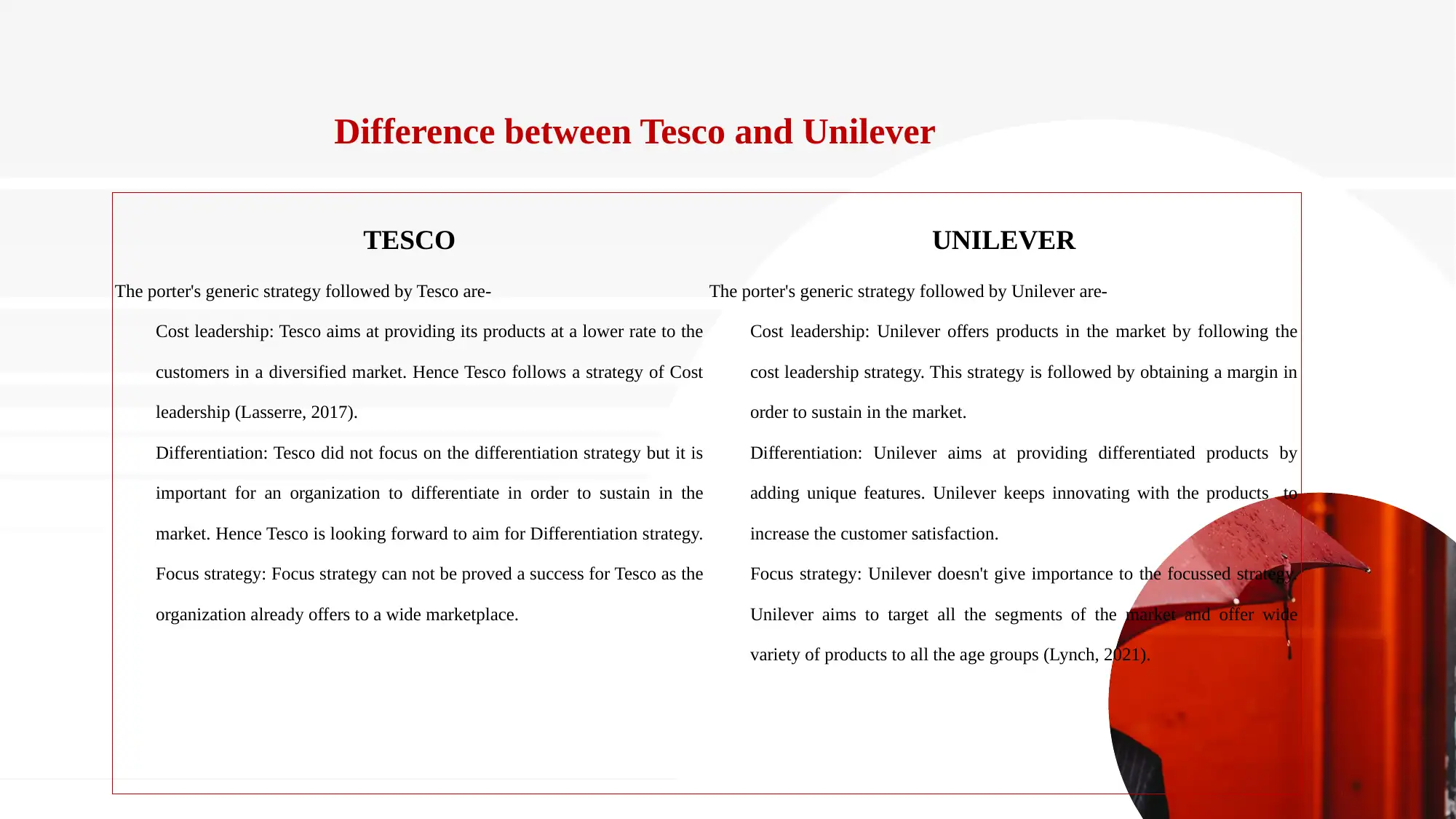
Difference between Tesco and Unilever
TESCO UNILEVER
The porter's generic strategy followed by Tesco are-
Cost leadership: Tesco aims at providing its products at a lower rate to the
customers in a diversified market. Hence Tesco follows a strategy of Cost
leadership (Lasserre, 2017).
Differentiation: Tesco did not focus on the differentiation strategy but it is
important for an organization to differentiate in order to sustain in the
market. Hence Tesco is looking forward to aim for Differentiation strategy.
Focus strategy: Focus strategy can not be proved a success for Tesco as the
organization already offers to a wide marketplace.
The porter's generic strategy followed by Unilever are-
Cost leadership: Unilever offers products in the market by following the
cost leadership strategy. This strategy is followed by obtaining a margin in
order to sustain in the market.
Differentiation: Unilever aims at providing differentiated products by
adding unique features. Unilever keeps innovating with the products to
increase the customer satisfaction.
Focus strategy: Unilever doesn't give importance to the focussed strategy.
Unilever aims to target all the segments of the market and offer wide
variety of products to all the age groups (Lynch, 2021).
TESCO UNILEVER
The porter's generic strategy followed by Tesco are-
Cost leadership: Tesco aims at providing its products at a lower rate to the
customers in a diversified market. Hence Tesco follows a strategy of Cost
leadership (Lasserre, 2017).
Differentiation: Tesco did not focus on the differentiation strategy but it is
important for an organization to differentiate in order to sustain in the
market. Hence Tesco is looking forward to aim for Differentiation strategy.
Focus strategy: Focus strategy can not be proved a success for Tesco as the
organization already offers to a wide marketplace.
The porter's generic strategy followed by Unilever are-
Cost leadership: Unilever offers products in the market by following the
cost leadership strategy. This strategy is followed by obtaining a margin in
order to sustain in the market.
Differentiation: Unilever aims at providing differentiated products by
adding unique features. Unilever keeps innovating with the products to
increase the customer satisfaction.
Focus strategy: Unilever doesn't give importance to the focussed strategy.
Unilever aims to target all the segments of the market and offer wide
variety of products to all the age groups (Lynch, 2021).
Paraphrase This Document
Need a fresh take? Get an instant paraphrase of this document with our AI Paraphraser
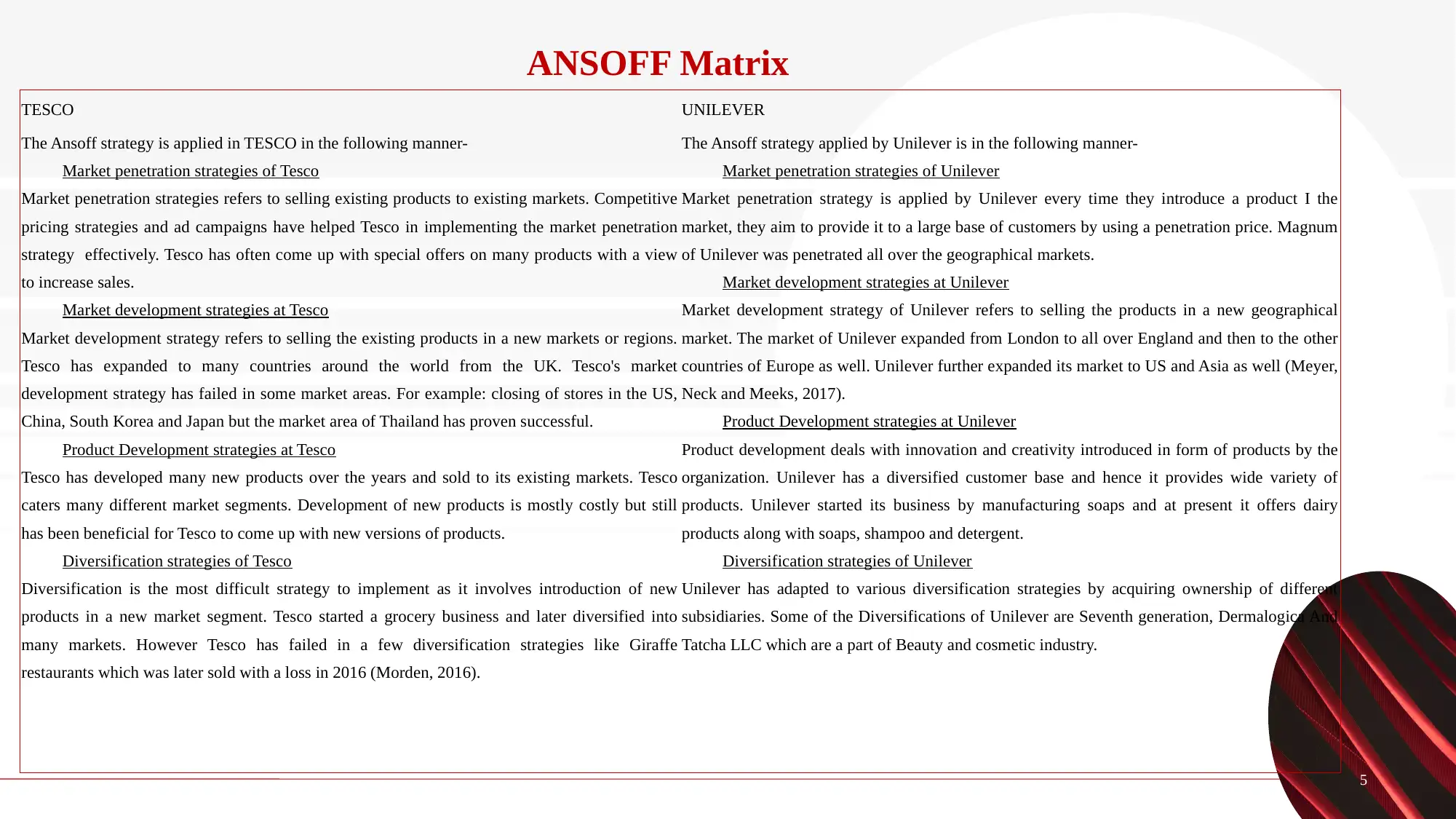
ANSOFF Matrix
5
TESCO UNILEVER
The Ansoff strategy is applied in TESCO in the following manner-
Market penetration strategies of Tesco
Market penetration strategies refers to selling existing products to existing markets. Competitive
pricing strategies and ad campaigns have helped Tesco in implementing the market penetration
strategy effectively. Tesco has often come up with special offers on many products with a view
to increase sales.
Market development strategies at Tesco
Market development strategy refers to selling the existing products in a new markets or regions.
Tesco has expanded to many countries around the world from the UK. Tesco's market
development strategy has failed in some market areas. For example: closing of stores in the US,
China, South Korea and Japan but the market area of Thailand has proven successful.
Product Development strategies at Tesco
Tesco has developed many new products over the years and sold to its existing markets. Tesco
caters many different market segments. Development of new products is mostly costly but still
has been beneficial for Tesco to come up with new versions of products.
Diversification strategies of Tesco
Diversification is the most difficult strategy to implement as it involves introduction of new
products in a new market segment. Tesco started a grocery business and later diversified into
many markets. However Tesco has failed in a few diversification strategies like Giraffe
restaurants which was later sold with a loss in 2016 (Morden, 2016).
The Ansoff strategy applied by Unilever is in the following manner-
Market penetration strategies of Unilever
Market penetration strategy is applied by Unilever every time they introduce a product I the
market, they aim to provide it to a large base of customers by using a penetration price. Magnum
of Unilever was penetrated all over the geographical markets.
Market development strategies at Unilever
Market development strategy of Unilever refers to selling the products in a new geographical
market. The market of Unilever expanded from London to all over England and then to the other
countries of Europe as well. Unilever further expanded its market to US and Asia as well (Meyer,
Neck and Meeks, 2017).
Product Development strategies at Unilever
Product development deals with innovation and creativity introduced in form of products by the
organization. Unilever has a diversified customer base and hence it provides wide variety of
products. Unilever started its business by manufacturing soaps and at present it offers dairy
products along with soaps, shampoo and detergent.
Diversification strategies of Unilever
Unilever has adapted to various diversification strategies by acquiring ownership of different
subsidiaries. Some of the Diversifications of Unilever are Seventh generation, Dermalogica And
Tatcha LLC which are a part of Beauty and cosmetic industry.
5
TESCO UNILEVER
The Ansoff strategy is applied in TESCO in the following manner-
Market penetration strategies of Tesco
Market penetration strategies refers to selling existing products to existing markets. Competitive
pricing strategies and ad campaigns have helped Tesco in implementing the market penetration
strategy effectively. Tesco has often come up with special offers on many products with a view
to increase sales.
Market development strategies at Tesco
Market development strategy refers to selling the existing products in a new markets or regions.
Tesco has expanded to many countries around the world from the UK. Tesco's market
development strategy has failed in some market areas. For example: closing of stores in the US,
China, South Korea and Japan but the market area of Thailand has proven successful.
Product Development strategies at Tesco
Tesco has developed many new products over the years and sold to its existing markets. Tesco
caters many different market segments. Development of new products is mostly costly but still
has been beneficial for Tesco to come up with new versions of products.
Diversification strategies of Tesco
Diversification is the most difficult strategy to implement as it involves introduction of new
products in a new market segment. Tesco started a grocery business and later diversified into
many markets. However Tesco has failed in a few diversification strategies like Giraffe
restaurants which was later sold with a loss in 2016 (Morden, 2016).
The Ansoff strategy applied by Unilever is in the following manner-
Market penetration strategies of Unilever
Market penetration strategy is applied by Unilever every time they introduce a product I the
market, they aim to provide it to a large base of customers by using a penetration price. Magnum
of Unilever was penetrated all over the geographical markets.
Market development strategies at Unilever
Market development strategy of Unilever refers to selling the products in a new geographical
market. The market of Unilever expanded from London to all over England and then to the other
countries of Europe as well. Unilever further expanded its market to US and Asia as well (Meyer,
Neck and Meeks, 2017).
Product Development strategies at Unilever
Product development deals with innovation and creativity introduced in form of products by the
organization. Unilever has a diversified customer base and hence it provides wide variety of
products. Unilever started its business by manufacturing soaps and at present it offers dairy
products along with soaps, shampoo and detergent.
Diversification strategies of Unilever
Unilever has adapted to various diversification strategies by acquiring ownership of different
subsidiaries. Some of the Diversifications of Unilever are Seventh generation, Dermalogica And
Tatcha LLC which are a part of Beauty and cosmetic industry.
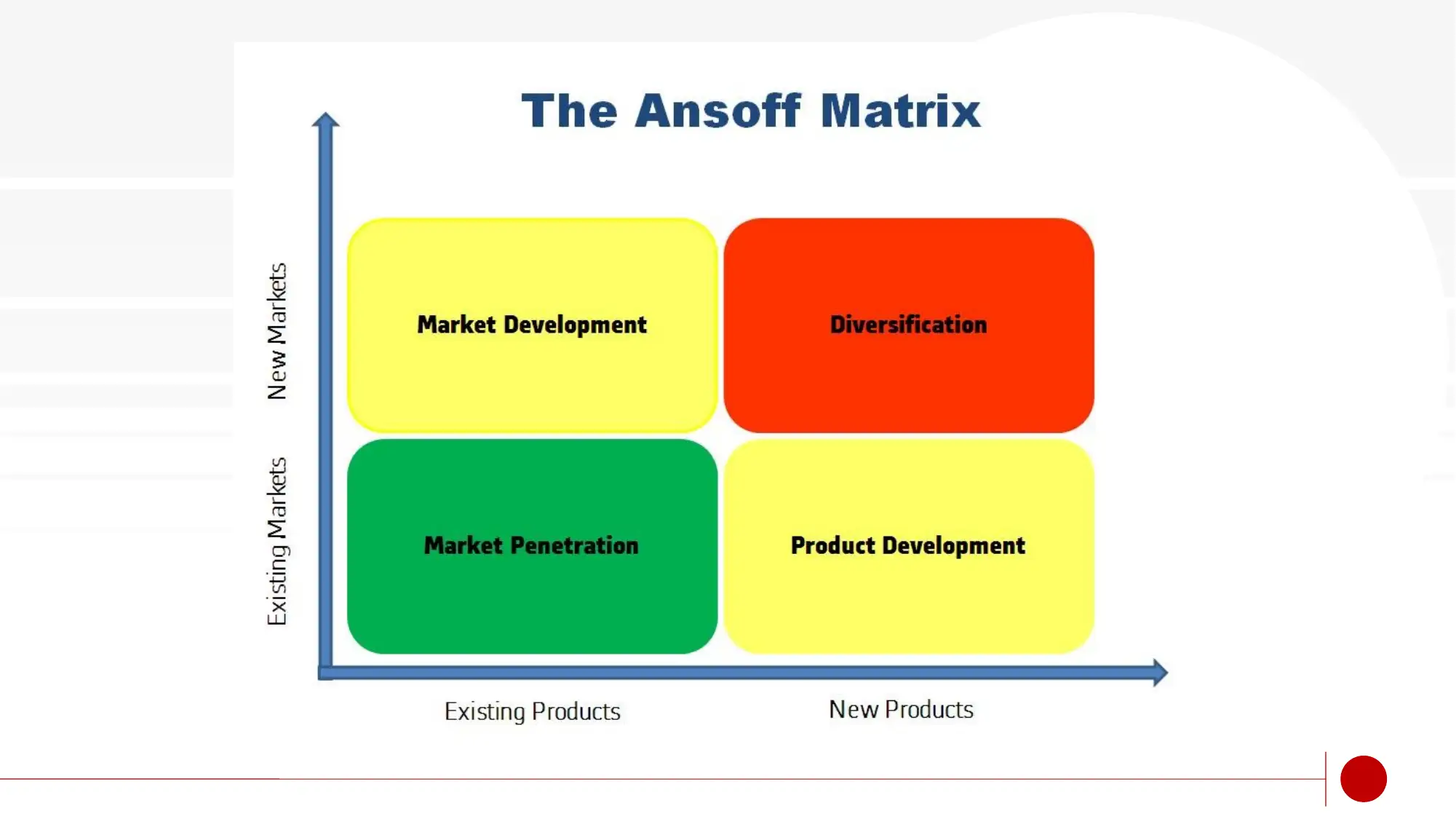
⊘ This is a preview!⊘
Do you want full access?
Subscribe today to unlock all pages.

Trusted by 1+ million students worldwide
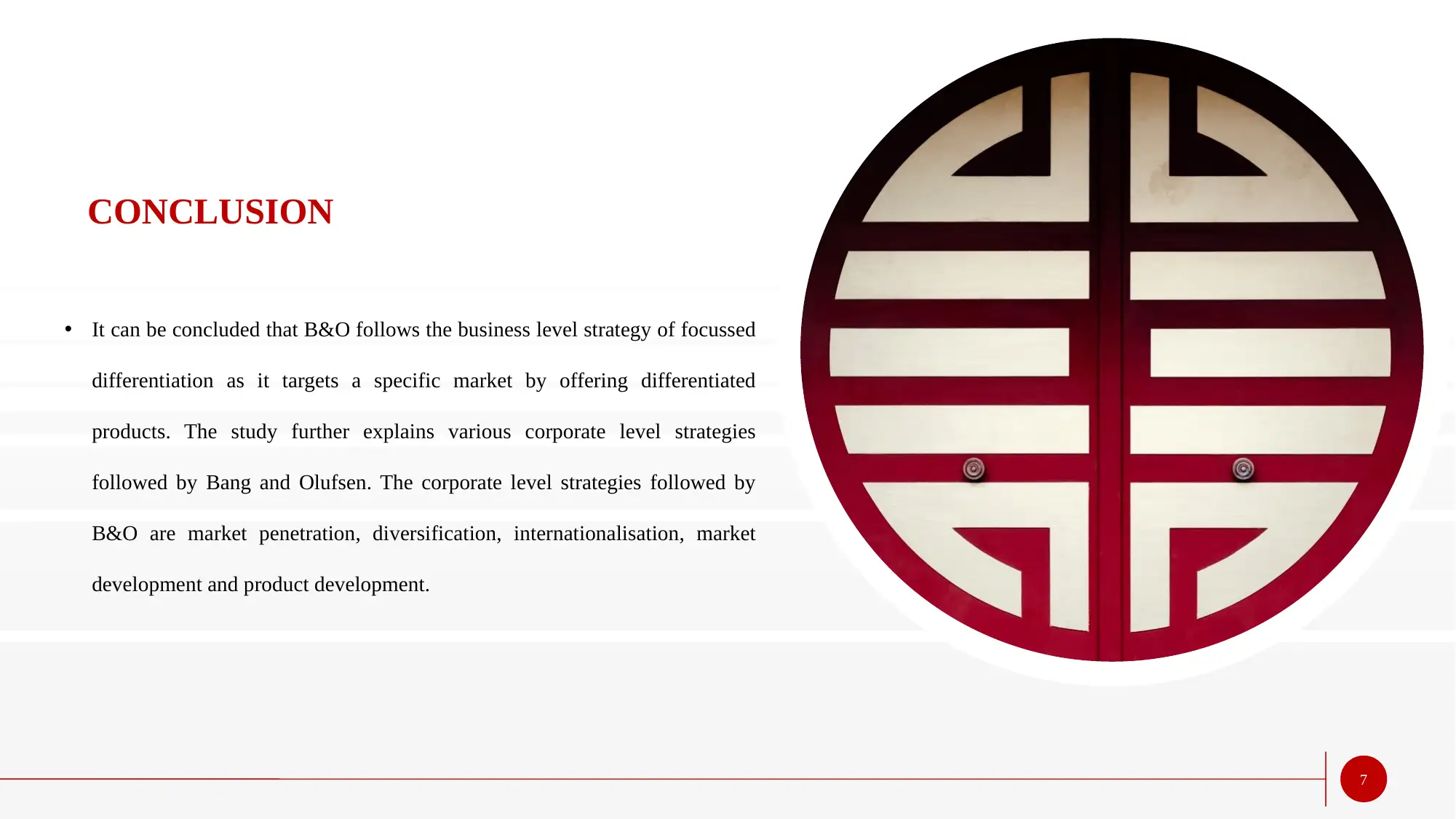
7
CONCLUSION
• It can be concluded that B&O follows the business level strategy of focussed
differentiation as it targets a specific market by offering differentiated
products. The study further explains various corporate level strategies
followed by Bang and Olufsen. The corporate level strategies followed by
B&O are market penetration, diversification, internationalisation, market
development and product development.
CONCLUSION
• It can be concluded that B&O follows the business level strategy of focussed
differentiation as it targets a specific market by offering differentiated
products. The study further explains various corporate level strategies
followed by Bang and Olufsen. The corporate level strategies followed by
B&O are market penetration, diversification, internationalisation, market
development and product development.
Paraphrase This Document
Need a fresh take? Get an instant paraphrase of this document with our AI Paraphraser
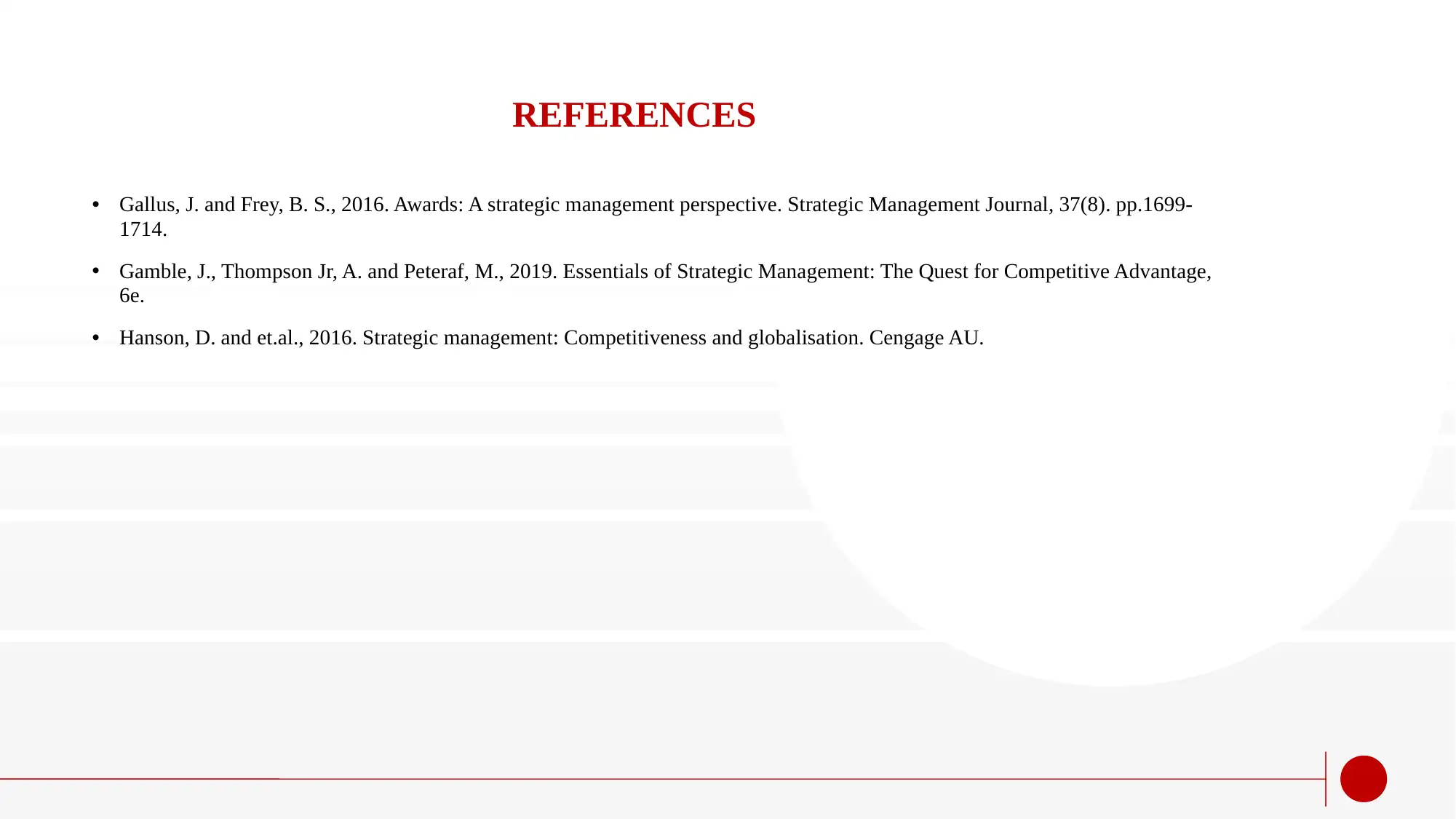
REFERENCES
• Gallus, J. and Frey, B. S., 2016. Awards: A strategic management perspective. Strategic Management Journal, 37(8). pp.1699-
1714.
• Gamble, J., Thompson Jr, A. and Peteraf, M., 2019. Essentials of Strategic Management: The Quest for Competitive Advantage,
6e.
• Hanson, D. and et.al., 2016. Strategic management: Competitiveness and globalisation. Cengage AU.
• Gallus, J. and Frey, B. S., 2016. Awards: A strategic management perspective. Strategic Management Journal, 37(8). pp.1699-
1714.
• Gamble, J., Thompson Jr, A. and Peteraf, M., 2019. Essentials of Strategic Management: The Quest for Competitive Advantage,
6e.
• Hanson, D. and et.al., 2016. Strategic management: Competitiveness and globalisation. Cengage AU.

THANK YOU
⊘ This is a preview!⊘
Do you want full access?
Subscribe today to unlock all pages.

Trusted by 1+ million students worldwide
1 out of 9
Related Documents
Your All-in-One AI-Powered Toolkit for Academic Success.
+13062052269
info@desklib.com
Available 24*7 on WhatsApp / Email
![[object Object]](/_next/static/media/star-bottom.7253800d.svg)
Unlock your academic potential
Copyright © 2020–2025 A2Z Services. All Rights Reserved. Developed and managed by ZUCOL.




